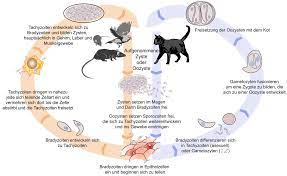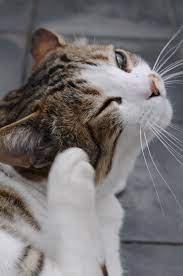“Understanding Toxoplasmosis: Myths and Realities of Cat-Related Risks”
Firstly before I continue discussing this topic, I want to state, that If you have concerns about toxoplasmosis, it’s a good idea to discuss them with a healthcare professional. Do not take my advice as I am not a medical professional. This article is for information purposes only to help you better familiarize with this seemingly scary topic.
Toxoplasmosis frequently stirs a blend of concerns and misconceptions, especially regarding potential risks linked to pet cats. However, delving deeper into the matter unveils a more nuanced and balanced outlook. Toxoplasmosis, caused by the parasitic infection Toxoplasma gondii, can undoubtedly spread through contact with cat feces. Nonetheless, the prevalent notion of contracting the infection from our feline friends often exaggerates the actual risk involved.

Toxoplasmosis stands as a notable parasitic infection intricately linked to the protozoan organism Toxoplasma gondii. This microscopic, single-celled parasite holds an intricate life cycle characterized by its dependence on both intermediate and definitive hosts. This cycle begins when the parasite enters the system of an intermediate host, which can encompass various warm-blooded animals, including rodents and birds. Once inside an intermediate host, Toxoplasma gondii goes through a process called “tachyzoite replication.” During this phase, the parasite multiplies rapidly and forms structures called “tachyzoites,” which are actively dividing forms of the parasite. This rapid replication allows the parasite to establish an infection within the host’s tissues.

Toxoplasma gondii reaches its final and most important stage inside cats. Domestic cats and other members of the felid family serve as the definitive hosts for this parasite. Inside these feline hosts, Toxoplasma gondii completes a crucial stage of its life cycle known as sexual reproduction. This reproductive process culminates in the generation of infectious oocysts—a critical form of the parasite’s lifecycle. These oocysts are then excreted into the environment through the cat’s feces.

This excretion of infectious oocysts represents a pivotal point in the life cycle of Toxoplasma gondii. These oocysts, when released into the environment, can persist and remain viable for extended periods, thus posing a potential risk of transmission to other animals, including humans. It is important to note that while cats are instrumental in the reproduction of the parasite, the risk of transmission to humans is typically not directly from the cat itself, but rather from exposure to contaminated environments, objects, or substances.
The immune system of the intermediate host responds to the infection by trying to contain and control the tachyzoites. In healthy individuals with intact immune systems, the immune response can often keep the infection in check, preventing the parasite from causing severe disease. One of the primary components of the immune response is the activation of immune cells, such as white blood cells and specialized immune proteins. These cells work together to identify and target the tachyzoites—the rapidly dividing forms of the parasite. Immune cells recognize specific components of the tachyzoites as foreign and mount an attack to neutralize them. As a result, the intermediate host might experience mild or no symptoms at all, and the infection might not progress to severe disease. However, it’s important to note that while the immune response can control the infection, it might not completely eliminate the parasite. Toxoplasma gondii has evolved strategies to evade immune detection and can form tissue cysts within the host’s cells. These cysts contain bradyzoites, the slower-growing forms of the parasite, which are more resistant to immune attack.

In some cases, especially when the immune response is compromised, the parasite can evade immune surveillance and cause more severe disease. For individuals with weakened immune systems, such as those with HIV/AIDS or undergoing immunosuppressive therapy, Toxoplasma gondii can reactivate and cause serious complications, including neurological problems.
One main reason for the difference in perceived risk of getting the infection from cats is that people often misunderstand how the infection spreads. While cats are the primary hosts for Toxoplasma gondii, they usually shed the infectious oocysts—the stage of the parasite that poses a risk to humans—for only a limited time after initial infection. The duration of time during which cats shed infectious oocysts after initial infection with Toxoplasma gondii can vary. Generally, shedding of oocysts by infected cats occurs for a period of about one to two weeks after they first become infected. After this initial shedding period, most cats develop immunity to the parasite, and the shedding of oocysts decreases or stops altogether. The exact timeline can be influenced by factors such as the cat’s age, health status, and the strain of the parasite. As cats develop immunity to the parasite, the shedding diminishes, reducing the risk of ongoing transmission. In fact, responsible cat ownership practices, such as proper litter box hygiene and handwashing, play a pivotal role in mitigating this risk even further.

The symptoms experienced by a person who contracts toxoplasmosis can vary widely based on several factors, including the individual’s overall health, age, and immune system function. In many cases, especially among healthy individuals, the infection might not cause noticeable symptoms, or the symptoms might be mild and flu-like in nature.
Common symptoms of toxoplasmosis include:
| Flu-Like Symptoms | Swollen Lymph Nodes | Sore Throat | Muscle Pain | Fever | General Malaise |
| Many people with toxoplasmosis experience symptoms similar to those of the flu, such as fever, fatigue, muscle aches, and headache | Enlarged lymph nodes, particularly in the neck, armpits, or groin, are a common sign of toxoplasmosis | A sore throat can be present, along with other upper respiratory symptoms | Muscle pain, often described as aches or soreness, can occur as part of the infection | A mild to moderate fever is a common symptom, usually lasting for a few days | Many individuals with toxoplasmosis might experience an overall sense of feeling unwell or fatigued |
It’s important to emphasize that these symptoms are not unique to toxoplasmosis and can be caused by various other infections as well. Additionally, the severity and duration of symptoms can vary widely. In healthy individuals with a strong immune system, symptoms might be mild and resolve on their own without requiring specific medical treatment.
However, toxoplasmosis can be of greater concern for certain vulnerable populations, including:

Pregnant Women: In pregnant women, toxoplasmosis can pose a risk to the developing fetus. Infection during pregnancy can lead to congenital toxoplasmosis, which might result in birth defects, vision problems, and developmental issues in the baby.

Immunocompromised Individuals: People with weakened immune systems, such as those with HIV/AIDS, organ transplant recipients, or individuals undergoing chemotherapy, are at a higher risk of severe toxoplasmosis. The infection can reactivate and cause more serious complications, particularly affecting the brain and other organs.
Cat litter itself is generally not considered toxic to humans, but it is important to take certain precautions when handling and disposing of it. Clumping clay litters can create dust when poured or scooped, which could potentially irritate the respiratory system if inhaled excessively. To minimize dust inhalation, it’s recommended to pour and scoop the litter in a well-ventilated area or consider wearing a dust mask. Pregnant women should be especially cautious due to the risk of toxoplasmosis, a parasitic infection found in cat feces that can harm a developing fetus. Toxoplasmosis risk can be reduced by delegating litter box cleaning tasks to others, wearing gloves, and washing hands thoroughly after handling cat litter.
In healthy individuals, a Toxoplasma infection might not cause noticeable symptoms or might only result in mild flu-like symptoms.

It is also worth mentioning that the perception that the risk of contracting toxoplasmosis from pet cats is often overstated. While cats are the primary host for Toxoplasma gondii, they usually only shed the infectious stage of the parasite for a limited time after they are first infected. After this initial shedding period, most cats become immune to the parasite and stop shedding it. Therefore, the likelihood of a cat continuously shedding infectious oocysts (the parasite’s stage that can infect humans) is relatively low. In addition, simple hygiene practices, such as washing hands after cleaning the litter box and avoiding contact with cat feces, significantly reduce the risk of transmission. Many people who follow proper hygiene practices do not contract the infection from their cats. Furthermore, people can contract toxoplasmosis through various other sources, including consumption of contaminated food, water, or soil. Pet cats are just one potential source. People can also become infected from consuming undercooked or raw meat from infected animals or through contact with contaminated environments. Sometimes, the media can sensationalize the risks associated with toxoplasmosis, leading to an exaggerated perception of the danger posed by pet cats. However, It’s still a good idea to practice proper hygiene when handling cat litter, especially for pregnant women and individuals with compromised immune systems. These precautions are not only for preventing toxoplasmosis but also for maintaining general health and hygiene. If you have concerns, discussing them with a healthcare professional can provide accurate information and guidance tailored to your individual situation.
Some other potential health concerns for humans while handling cat litters
Some litters may contain fragrances or additives that might cause irritation or allergic reactions in sensitive individuals, so opting for unscented or hypoallergenic litters could be beneficial. Practicing good hygiene by washing hands thoroughly after handling litter and avoiding touching the face is essential. Lastly, considering eco-friendly litter options can help mitigate environmental impacts associated with traditional clay or silica gel litters.
Clumping Clay Litter Dust: Clumping clay litter can produce dust when poured or scooped, and inhaling excessive dust could potentially irritate the respiratory system. It’s a good practice to pour and scoop the litter in a well-ventilated area or wear a dust mask to minimize inhalation of dust particles.
Toxic Litter Additives: Some litters may contain fragrances, deodorizers, or additives that could cause irritation or allergic reactions in sensitive individuals. It’s a good idea to choose unscented or hypoallergenic litters if you’re concerned about potential reactions.
Dust and Tracking: Cat litter can be easily tracked around the house on shoes and paws, which can introduce dust and potentially allergenic materials to your living spaces. Regular cleaning and vacuuming can help minimize this.
Proper Hygiene Practices: Regardless of the type of litter you use, always practice good hygiene by washing your hands thoroughly with soap and water after handling cat litter, and avoid touching your face, mouth, or eyes while handling it.
Environmental Concerns: Some types of cat litter, especially those made from clay or silica gel, can have environmental impacts due to the resources required for their production and the way they decompose in landfills. Eco-friendly litter alternatives, such as those made from recycled paper, corn, or wood, are available and may be more environmentally responsible choices. If you have specific concerns about the type of cat litter you’re using or any potential health risks, it’s a good idea to consult with your veterinarian or a medical professional for advice






